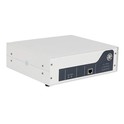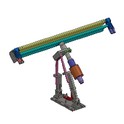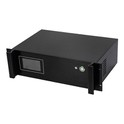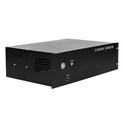Hey there! I'm a supplier of ultrasonic rings, and today I'm super stoked to chat with you about how these nifty gadgets can revolutionize the pharmaceutical industry.
Let's start by getting a basic understanding of what an ultrasonic ring is. It's a device that generates ultrasonic waves. These waves create a phenomenon called cavitation. In simple terms, tiny bubbles form and then collapse rapidly in a liquid medium. This action can do some pretty amazing things, especially in the pharma world.
1. Mixing and Homogenization
One of the most crucial processes in the pharmaceutical industry is mixing different substances to create a homogeneous product. Whether it's combining active pharmaceutical ingredients (APIs) with excipients or blending different liquids, getting a uniform mixture is key.
Ultrasonic rings can be a game - changer here. When you place an ResoRing - 30 Ultrasonic Ring in a mixing tank, the cavitation bubbles it produces cause intense agitation. This agitation is much more effective than traditional mixing methods like mechanical stirring.
The rapid collapse of the bubbles creates high - speed micro - jets and shockwaves. These forces break down any clumps or aggregates in the mixture, ensuring that every part of the solution has the same composition. For example, in the production of emulsions, where oil and water need to be mixed evenly, an ultrasonic ring can achieve a much finer and more stable emulsion compared to other techniques. This is crucial because a well - mixed product is more likely to have consistent quality and efficacy.
2. Particle Size Reduction
In the pharmaceutical industry, the size of the particles in a drug formulation can significantly affect its bioavailability. Smaller particles generally dissolve faster and are more easily absorbed by the body.
Ultrasonic rings are excellent at reducing particle size. The cavitation bubbles generated by the ResoRing - 25 Ultrasonic Ring apply intense pressure and shear forces on the particles. When these forces act on large particles, they break them down into smaller ones.
This is particularly useful in the production of solid - dosage forms like tablets and capsules. By reducing the particle size of the APIs, the drug can be more effectively released in the body, leading to better therapeutic outcomes. Also, in the case of injectable drugs, smaller particle sizes reduce the risk of clogging needles and improve the overall safety of the injection.
3. Cleaning and Sterilization
Cleanliness is of utmost importance in the pharmaceutical industry. Contamination can lead to serious health risks for patients. Ultrasonic rings can play a vital role in cleaning and sterilizing equipment.
When placed in a cleaning solution, the ultrasonic waves from the ring create cavitation bubbles that can reach into the tiniest crevices and corners of pharmaceutical equipment. These bubbles dislodge dirt, debris, and even microorganisms from the surfaces.
For example, in the cleaning of vial filling machines, an ultrasonic ring can ensure that all the internal parts are thoroughly cleaned. This not only helps in preventing cross - contamination between different batches but also extends the lifespan of the equipment. And since ultrasonic cleaning is a non - abrasive method, it won't damage the delicate components of the machinery.
4. Dissolution Enhancement
Some drugs have poor solubility in water, which can pose a challenge in formulating effective medications. Ultrasonic rings can enhance the dissolution rate of these poorly soluble drugs.
The cavitation effect created by the ring disrupts the surface of the drug particles, increasing their contact area with the solvent. This allows the drug to dissolve more quickly. In the development of new drug formulations, this can be a huge advantage. It means that drugs that were previously difficult to formulate due to solubility issues can now be made into more effective and patient - friendly dosage forms.
5. Sonocrystallization
Crystallization is an important step in the production of many pharmaceutical products. The size, shape, and purity of the crystals can affect the properties of the final drug. Ultrasonic rings can be used to control the crystallization process through a technique called sonocrystallization.
The ultrasonic waves can induce nucleation, which is the initial step in crystal formation. By controlling the frequency and intensity of the ultrasonic waves, you can influence the size and shape of the crystals. For example, you can produce smaller, more uniform crystals, which are often preferred in the pharmaceutical industry because they have better flow properties and are easier to process into tablets or capsules.
How to Choose the Right Ultrasonic Ring
Now that you know the many benefits of using ultrasonic rings in the pharmaceutical industry, you might be wondering how to choose the right one for your specific needs.
First, consider the volume of the solution or the size of the equipment you'll be using it with. If you have a large - scale production process, a more powerful ultrasonic ring like the ResoRing - 30 Ultrasonic Ring might be more suitable. On the other hand, for smaller - scale operations or for cleaning smaller pieces of equipment, the ResoRing - 25 Ultrasonic Ring could be a better choice.
Also, think about the frequency of the ultrasonic waves. Different frequencies have different effects. Higher frequencies are better for fine - scale cleaning and particle size reduction, while lower frequencies are more effective for larger - scale mixing and homogenization.


Contact for Procurement
If you're interested in incorporating ultrasonic rings into your pharmaceutical production process, I'd love to have a chat with you. We can discuss your specific requirements and find the perfect ultrasonic ring solution for your business. Whether you're a small - scale pharmaceutical startup or a large - scale manufacturer, we've got the expertise and products to meet your needs. So, don't hesitate to reach out and start a conversation about how these amazing devices can take your pharmaceutical production to the next level.
References
- Povey, M. J. W. (1997). Industrial applications of ultrasound: An overview. Ultrasonics, 35(1 - 6), 47 - 60.
- Mason, T. J., & Lorimer, J. P. (2002). Applied sonochemistry: Uses of power ultrasound in chemistry and processing. Royal Society of Chemistry.
- Suslick, K. S., & Price, G. J. (1999). Applications of ultrasound to materials chemistry. Annual Review of Materials Science, 29(1), 295 - 326.






